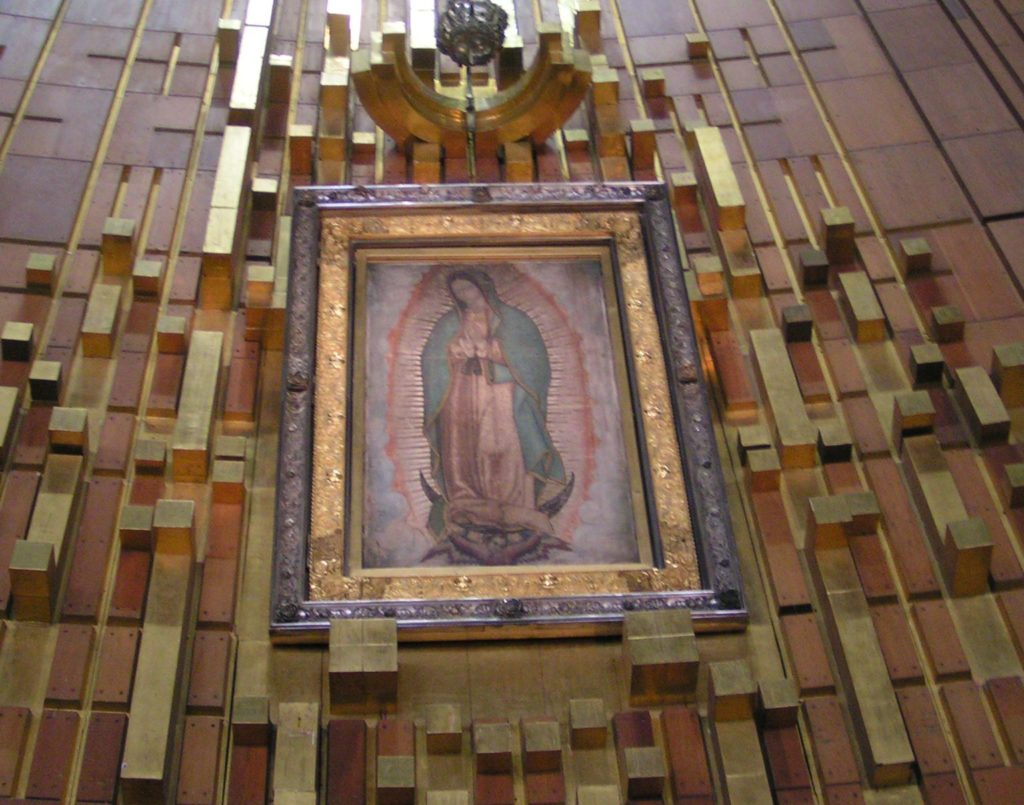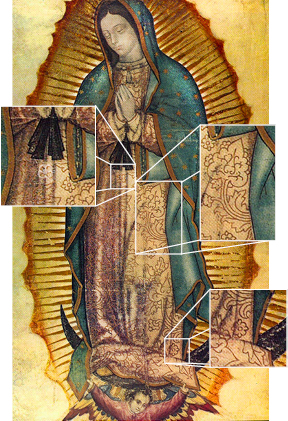Our Lady of Guadalupe
November 30, 2012/

Carl Anderson underscores the incredible complexity of the Image. Every detail about the image had a meaning for the indigenous people, The image itself was a pictographic codex, a method traditionally used to record and transmit religious and cultural practices before the arrival of the Spanish. Here are some of the key elements.
- The colour of her skin stands out, neither pale like the Spaniards, nor dark like the indigenous, she is a mestiza, a mixed-blood. This identified her with completely with the New World, affirming the uniqueness of both Spanish and Indigenous culture and presenting herself as the link between the two as their mother.
- She stood with the sun at her back and the moon at her feet, traditional imagery associated with the Woman of the Apocalypse (Rev 12:1). To the Aztecs, this symbolised her power over the blood-thirsty Sun god Huitzilopochtli and the lunar, feathered serpent, Quetzalcoatl. This showed a new path to cosmological harmony without human sacrifice, a radical new conception of the universe.
- Beneath her feet is an angel with jewel-coloured eagle wings. The eagle in Aztec culture was a herald of civilisation and the symbolic conveyor of the Aztec’s sacrificial offerings to the gods. This eagle-winged Angel is a herald of a new civilisation and the carrier of the new and ultimate sacrifice in Christ the redeemer. The eagle-winged angel shifted the religious orientation of the Aztecs, instead of striving to touch divinity, this eagle-winged angel brings God to them. This connects to Juan Diego’s indigenous name, Cuauhtlatoatzin which means ‘one who speaks like an eagle’, this humble man was the messenger and herald of this new civilisation.
- She is pregnant. The black sash is normally worn at the waist by Aztec women is worn higher up during pregnancy.
- The stars on her veil map the positions of the constellations in the sky at the time of the apparition. The blue-green colour was a special colour reserved for Aztec emperors and divinity. The rich pink of her tunic represents the earth. The meeting of the veil and tunic in the hands of the angel represent a cosmic harmony from which new-life will come forth. The miraculous image was instituted on the Winter Solstice, a significant day for the Aztecs and also in European Christianity. The Winter Solstice was the shortest day of the year, from which point the days would begin to lengthen. It was symbolic of rebirth and new life.
- Her tunic is covered with gold flowersthat were much more than decoration; they were symbols representing words and concepts in Nahutal.
- The most significant is the Jasmine flower. This simple four-petal flower represented the highest, single divine being, Ometetol, who did not concern himself with the affairs of humanity. This flower is positioned over her womb, identifying her child as divine and more radically, this remote, omnipotent being is now reachable by any human being who delivers himself to humanity through his mother. Our Lady of Guadalupe speaks of her Son in the same titles attributed to Ometetol.
- The eight-petaled flower appears eight times and represents the planet Venus. The movement of Venus was a significant measure in the Aztec calendar which by the time of the conquest, had become inaccurate and often was in opposition to the solar measurements. The presence of both the sun and Venus with neither dominating the other represents a new cosmological harmony and peace.
- The large flower clusters represent a new communal concept in Nahutal. The large triangle blossom represents ‘hill’ and the long curved stem ‘water’ which together, represent the concept of nation or civilisation. These particular glyphs were highly significant symbols, mountains and rivers were the most essential geographic features necessary for human life. When the flower cluster is turned upside down, it becomes a human heart and arteries, representing sacrifice in an entirely new way, in which a divine heart and blood, not a human one carries the sacrificial burden in love.
- Her posture indicates a profound humility, pointing towards someone to whom she prays. This is indicated in her clasped hands and down-turned gaze, a gesture understood by both cultures. Significantly for the Aztecs, her entire body is in motion. Her weight is on one foot with the other knee bent in a dance-step position, which was the highest form of prayer for the Aztecs.
References:
Carl Anderson, Our Lady of Guadalupe: Mother of the Civilisation of Love, Double Day, New York, 2009.
Share this story, choose your platform
Comment Policy
We love to hear your stories and ideas. Please keep your comments respectful, your suggestions productive and published under your own name. More info here

